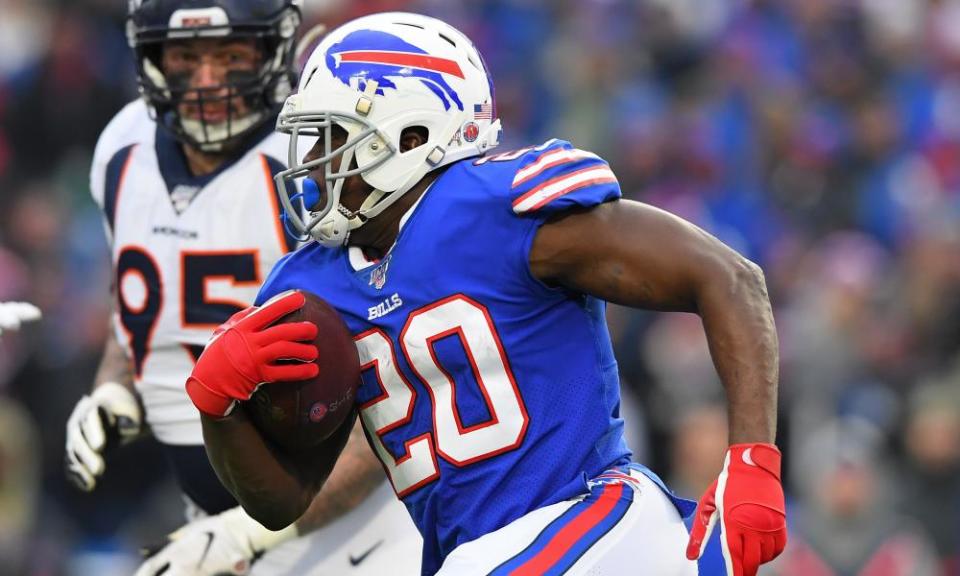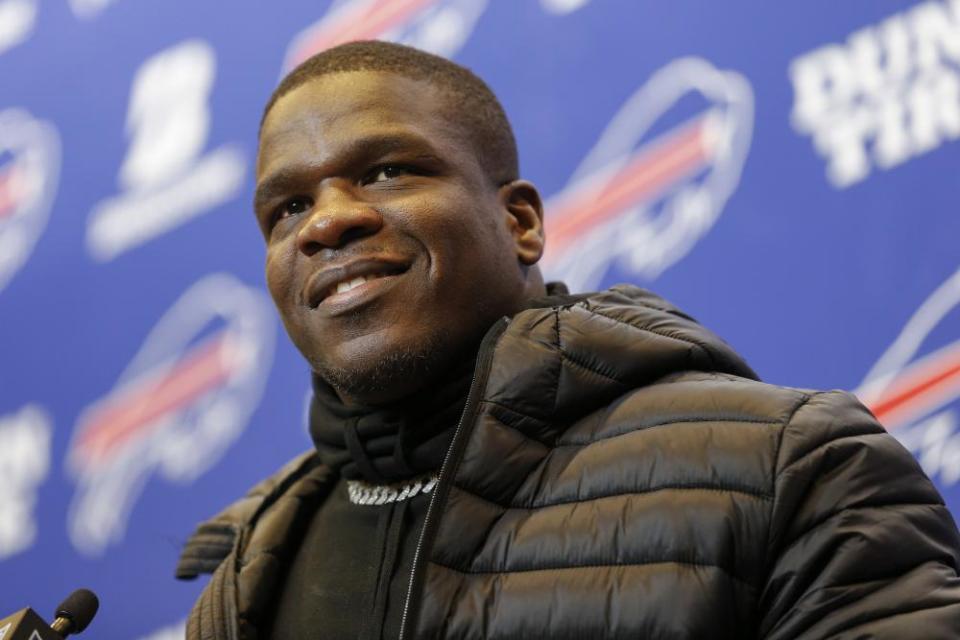Buffalo's ageless Frank Gore: the bell-cow back who's doing the impossible

A great running back has a career that’s easily reduced to a 10-second highlight. For Cleveland’s Jim Brown, it’s a black-and-white montage of him barreling through wall after wall of humanity to paydirt. For Chicago’s Walter Payton, we smash-cut from Sweetness sloughing off would-be tacklers like George Costanza fleeing a smoking kids’ party to Sweetness dolphin-diving over a stacked front onto a concrete end zone. For Detroit’s Barry Sanders, roll that clip from the 1992 playoffs of him going all Great Tiger on the eventual Super Bowl champion Dallas Cowboys.
As for the Buffalo Bills’ Frank Gore? Well, his greatness isn’t easily GIF’d. Look up the five-time Pro Bowler’s highlights on YouTube, and, sure, the hits – mostly of him jetting through scrums in his younger days and piling up yards after contact now – aren’t bad. It’s just not the kind of mental time-capsule fodder that autoplays at the very mention of his name.
Nevertheless: all of Gore’s efforts, however pedestrian they might seem in comparison to those monumental rushers, added up to something quite spectacular just the same. With a 65-yard afternoon against Denver on 24 November, Gore slipped past Sanders into third place on the NFL’s all-time rushing list; 26 more yards in Buffalo’s season-finale against the New York Jets last Sunday left Gore with a staggering 15,347 yards for his career, a running total that now only trails those of Payton (16,726) and Cowboys icon Emmitt Smith (18,355). Throw in Gore’s 3,896 yards receiving, and he becomes the only runner other than Payton to amass more than 15,000 yards on the ground and more than 3,500 through the air.
All this in what was a down year for the 5ft 9in, 212lb Gore, one that saw him register career lows in total yards (599) and yards per carry (3.6). Still: there’s no doubt his modest contributions and leadership behind the scenes are a big reason why the Bills are back in the playoffs for the second time in three seasons. (And all this after an 18-year drought, once the longest in North American pro sports.) On Saturday they’ll pit their top-10 rushing attack against the Houston Texans’ bottom-10 rush defense and play for a wild-card upset on the road.
That Gore should feature prominently in these epic milestones – and not, say, former Chiefs dynamo Jamaal Charles or former Titans dazzler Chris Johnson or former St. Louis Ram bruiser Steven Jackson – beggars belief. Consider: this is a 36-year-old dude playing on his third team in five seasons, after spending the first decade of his career in San Francisco. By rights, Gore should be opening up a restaurant or settling into an analyst gig or home getting his college-bound son, Frank Gore Jr, ready for his own running back career instead wintering in Buffalo in preparation for his first playoff appearance in six years.
What’s more, pro football isn’t just a pass-first league now; it’s a pass early and often league. The modern game claims to have no place for a bell-cow back with Gore’s bona fides. And yet this dude abides. With each new handoff, he lowers his shoulders and steams ahead, face mask jutting out like a cowcatcher, yards piling up all the while. His silent protest of the NFL’s pass wacky era alone should mark him as a gridiron wizard. Yet when a jury of football druids compiled a list of the NFL’s best 100 players ever for the occasion of the league’s centennial, Gore’s name was nowhere to be found on a running back roster that included Brown, Payton, Sanders and Smith.
On the one hand that figures. Gore has yet to win a Super Bowl, falling a goal line stand short when the Colin Kaepernick-led San Francisco 49ers faced the Baltimore Ravens in 2013 despite rushing for a game-high 110 yards on 19 carries. Gore also has never finished better than third on the single-season rushing yardage list and isn’t likely to improve in that area as opportunities diminish with age. Worst of all, his style is so unassuming. He’s not much of a first-down celebrator or an end-zone dancer. Strip away the stakes, and the carry on which he pipped Sanders – a fourth-quarter burst through the teeth of the Broncos line that went for seven yards – becomes about as exciting as the sight of Sanders calmly handing the ball off to an official after one of his unreal touchdown scampers. Call him “Frank Bore”.
On the other hand you’d be hard pressed to name a modern tailback who’s proven as durable as “Frank the Tank,” a workout warrior who has missed only two games since 2011. For any other pro tailback, this would be a remarkable achievement. In Gore’s case, it should never have happened. After all, he grew up poor in Coconut Grove, Florida, sharing a two-bedroom house with nine other relatives – not least a mother with a grave cocaine addiction. He suffered from a crippling form of dyslexia that nearly kept him out of college. At the University of Miami he was buried on a depth chart that at points featured Clinton Portis, Willis McGahee and Najeh Davenport – future Sunday stars, all. When Gore finally reached the field, he tore the anterior cruciate ligaments in both his knees.

Following a successful rehab timed to the 2005 NFL draft, Gore saw his slim chance of turning pro narrow yet again after showing up overweight to the scouting combine and posting a six out of 50 on the Wonderlic Test – a score 14 points below average and four points below the standard for literacy. That was enough for the handful of teams that had kicked the tires on Gore to consider other prospects. Only the 49ers didn’t flinch, selecting Gore at the top of the third round. And he promptly repaid their loyalty by dedicating the next 10 seasons to becoming the best back in the history of that Tiffany franchise. Not even two bum shoulders that would require reconstructive surgery after his rookie season slowed him down.
Gore was no less determined after leaving San Francisco to sign with Indianapolis, or after leaving Indy for Miami three years later. And though he continued to lead those teams in rushing even as his efficiency tapered, Gore failed in his quest to return to the heights he had reached in San Francisco. Last March he started over again in Buffalo, signing a one-year deal for $2m to share a backfield with fellow Pro Bowler LeSean McCoy. Five months later the Bills cut McCoy loose, leaving Gore to serve as a mentor to rookie running back Devin Singletary and second-year quarterback Josh Allen – a Gore jersey owner in his youth, as it happens. Together, they are the heart of the most rugged playoff offense outside of Nashville and the most exciting Bills offense since Flutiemania. Which is to say: perhaps this right here is the signature Gore highlight we’ve been waiting for.
And while his particular strain of genius might not be so obvious, this much is clear: game recognizes game. After the historic Denver game, Gore was pressed by the Broncos fearsome pass rusher Von Miller for his game-worn jersey and, later, blitzed with video messages from Sanders, Smith and his son among other prominent well-wishers. To a man, they encouraged Gore to keep going – with McGahee pushing his Miami teammate not to stop until he reaches the top of the all-time rushing list. And, shoot, if Tom Brady can break records in his 40s, there’s little reason to believe Gore can’t as if he stays healthy and keeps having fun, and teams can still find use for him. The only question is whether he can do it in a Buffalo uniform.
That said: it’s not a question that the Bills’ table-slamming faithful figure to be asking this week, as they urge Gore on in hopes witnessing the team’s first postseason victory since 1995. Another running back might shudder under that kind of pressure. But, clearly, Gore thrives under pressure. He just has a funny way of showing it.

